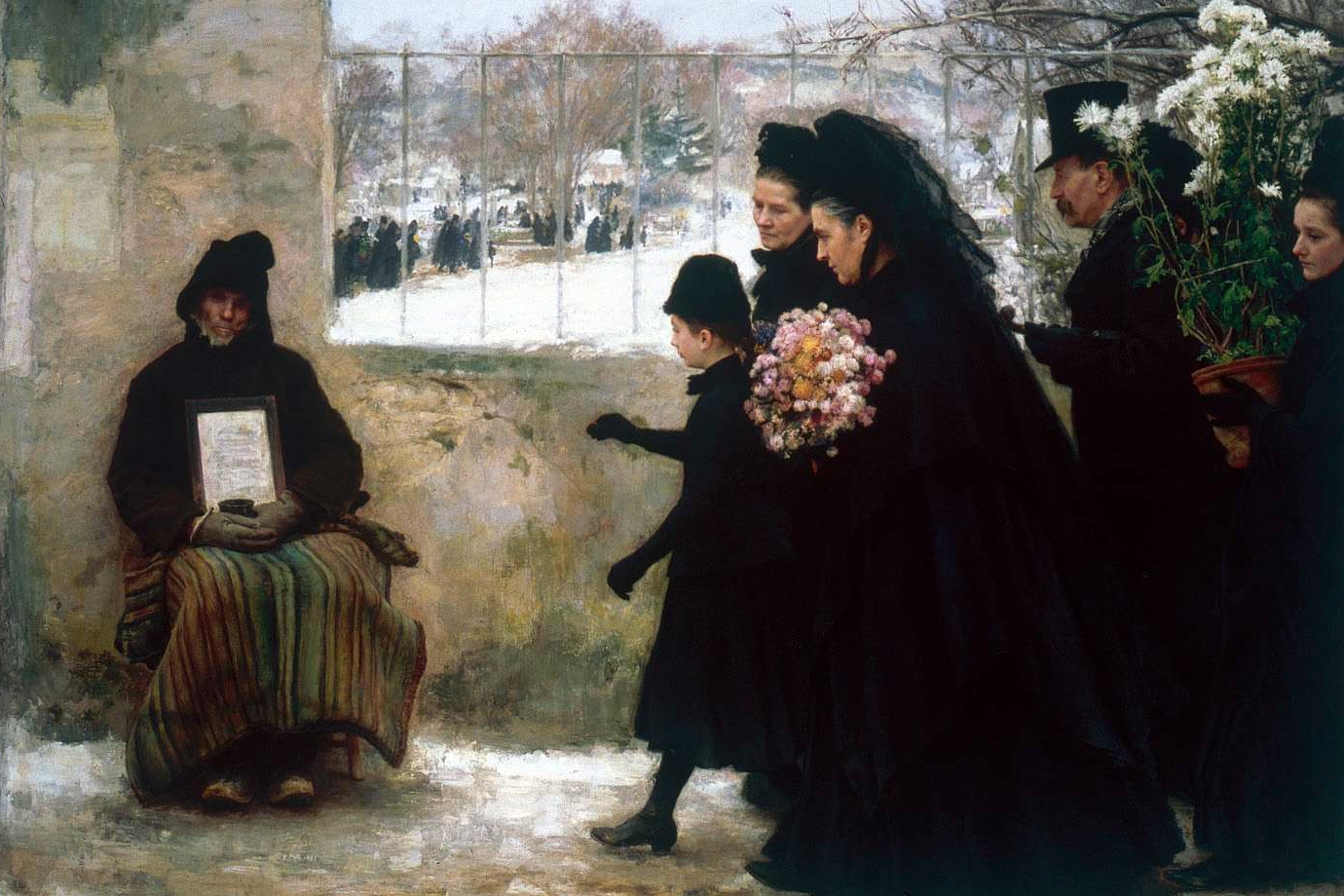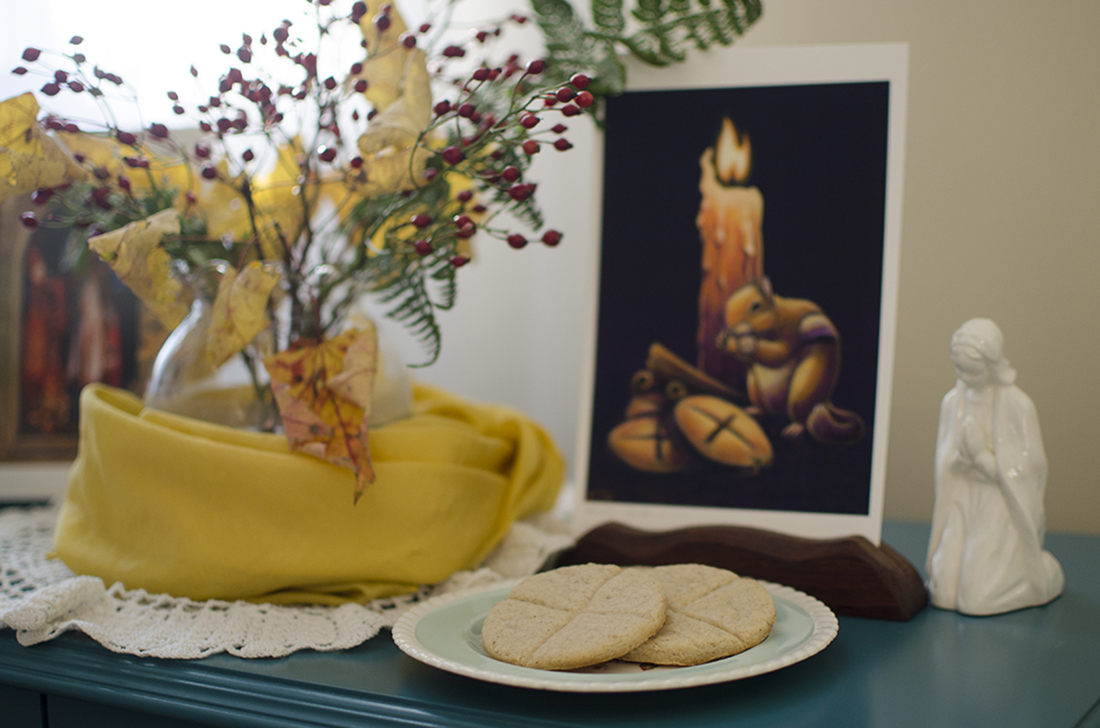
Remember that when you leave this Earth, you can take with you nothing that have received—only what you have given.
—St Francis of Assisi

All Saints and All Souls Days, preceded by their vigil, All Hallows’ Eve (or Hallowe’en), form a triduum in the fall season, sometimes known as Allhallowtide, that occurs every year between October 31st and November 2nd. These special days celebrate three important aspects of the Communion of Saints:
- The Church Militant (the Faithful on Earth) on All Hallows Eve
- The Church Triumphant (the Saints in Heaven) on All Saints Day
- The Church Suffering (the Souls in Purgatory) on All Souls Day
While it may seem a little strange, or even morbid, to celebrate the dead, these three days are truly a festival of hope. They offer us an opportunity to express our joy for the saints in heaven, and ask them to pray for us so that we may someday be counted among them.1 Let’s take a closer look at some European traditions associated with these three important days in the Church year.
Ireland :: Hallowe’en, All Saints, & All Souls
In Ireland many of the Allhallowtide customs have fallen out of favor, but we can look to the past to discover the rich traditions that were once common there during these important feast days. Even from pagan times it was believed in Ireland that the veil between our world and the afterlife was lifted during Allhallowtide. The Irish believed that their ancestors could return and speak to them, imparting their memories of olden times and strengthening the familial ties between the living and the dead. In preparation to reunite with their deceased relatives, Irish families would clean their homes and put out place settings for each of departed family member.2
As in America, costumes have long been associated with Hallowe’en in the Ireland. During Allhallowtide, merrymakers would don disguises and go from door to door “guising” or begging for food and alms—costumes of saints and angels were very popular. Some observed the vigil of All Saints by saying prayers for the departed including family, friends, clergy, and the forgotten dead, as well as praying a rosary for the souls in purgatory. Giant bonfires were lit to ward off evil spirits and to show that light always conquers darkness.3
For Irish Catholics, and Catholics throughout the world, All Saints Day is a holy day of obligation, so attending Mass is the central activity of the day. The fixed date of November 1st for All Saints Day has been in place since at least the 8th century, though the feast itself dates all the way back to the 4th century when Christianity was finally made legal. At that time a feast commemorating all the martyrs and saints was instituted by the Church.4
On All Souls Day many Irish households would bake soul cakes for the beggars who would come asking for food and alms in return for prayers for departed souls—called “soul-caking.” Sometimes soul cakes were also baked for the dead.5 Many Irish families would also visit cemeteries on All Souls Day to clean the graves of their loved ones, say prayers for them, and leave a candle burning in their memory.6
France :: La Toussaint & Le Jour des Morts
In France, All Saints Day is known as La Fete de la Toussaint or La Toussaint, which comes from the contraction of Tous les Saints (all the saints). All Souls Day is known as Le Jour des Mort (day of the dead).7
La Toussaint is a national public holiday in France, so many people have the day off from work. It is for this reason that one of the most popular La Toussaint traditions is gathering with family to visit the graves of loved ones who have passed away. Families gather in cemeteries to clean the graves, remove weeds, and decorate with pots or bouquets of fresh flowers, the most common being chrysanthemums (chrysanthèmes).8
The origins of the use of chrysanthemums for La Toussaint is unclear, but many believe it dates back to the end of the first World War when the president of France urged his countrymen to lay flowers on the graves of fallen soldiers—chrysanthemums were the only flowers available at that time of year, and so they became ever-after associated with remembrance.9 Chrysanthemums are also a natural choice for La Toussaint because of their long flowering period and ability to withstand the cold temperatures of late autumn. Unlike in America, where chrysanthemums serve as cheerful fall decor, in France it would be considered in bad taste to use these flowers for any purpose other than honoring the dead.
While Ireland has its soul cakes, France has its own medieval treat associated with La Toussaint. The niflette is a rich, cream-filled pastry that originates in the village of Provins. Legend has it that the name “niflette” derives from the Latin ne flete, meaning “don’t flinch” or “don’t cry.” Depending on who you ask, either bakers or monks prepared the little cakes as a consolation for orphans who were weeping after visiting the graves of their parents. “Nifelt” is also a nickname given to those who indulge in gourmet food, so there may be a connection there, as well.10 In prior times, niflettes were sold in the streets by young people carrying them in a wicker basket or copper pan. They would sing a sweet melody to entice villagers to come and purchase their cakes.11
Germany :: Allerheiligen & Allerseelen
As in France, All Saints Day—called Allerheiligen in German—is a public holiday. And, as in other countries, it tends to be celebrated in tandem with All Souls Day (Allerseelen), as the traditions from the two days have become interwoven over the years.12
The main event in Germany on Allerheiligen is visiting family graves to bless them and decorate them with candles, autumn flowers, and sprigs of heath that can last through the winter. Evergreen branches may also be used to symbolize eternal life.13 Similar activities take place on All Souls Day. Sometimes the family will walk silently into the cemetery and place candles on the graves of their loved ones.14
After returning from the cemetery families gather and share a special bread called Allerheiligenstiezel (also called Allerheiligenwecken, Allerheiligenzopf, or Seelenzopf). This brioche-style, braided bread used to be given to the poor and children who would then say a prayer for the dead, and now it is common for godparents to give Allerheiligenstriezel to their godchildren.15 Children may also receive a Seelenbreze or “soul pretzel.” Raisins are sometimes added to this sweet, rather than savory, pretzel dough, or it may be sprinkled with cinnamon sugar.
Celebrating Allhallowtide with Children
As you can see, there are many wonderful traditions associated with these important feast days. A common thread among all of them is honoring deceased family members. If you are lucky enough to live near to where your ancestors also made their homes, then it might be nice to go and visit their graves and leave flowers for them. Chrysanthemums would certainly be appropriate—they are a lovely flower that will brighten even the gloomiest cemetery.
Hosting an All Saints party on Hallowe’en might also be fun. Children could come dressed as their patron or another favorite saint, and see if others can guess who they are! And, of course, no Allhallowtide celebration would be complete without a tasty treat. I’ve shared my favorite soul cake recipe below, but you might also like to try making French niflettes or German seelenbrezen, too.
Praying for the dead is also an important aspect of these holy days, especially for those who have no one else to pray for them. Of course, this is something we can do at any time. As Fyodor Dostoyevsky says, in the voice of his character Father Zosima:16
. . . [E]very day and whenever you can, repeat to yourself, “Lord, have mercy on all who appear before Thee today.” For every hour and every moment thousands of men leave life on this earth, and their souls appear before God. And how many of them depart in solitude, unknown, sad, dejected, that no one mourns for them or even knows whether they have lived or not. And behold, from the other end of the earth perhaps, your prayer for their rest will rise up to God though you knew them not nor they you. How touching it must be to a soul standing in dread before the Lord to feel at that instant that, for him too, there is one to pray, that there is a fellow creature left on earth to love him too.
This quote, to me, is the essence of Allhallowtide. Wishing you a very blessed Hallowe’en, All Saints, and All Souls!
ENDNOTES
1Ruadhán Jones, “The Forgotten Triduum of Allhallowtide,” The Irish Catholic, www.IrishCatholic.com, 20 October 2020
2“Making the Dead Welcome – All Souls Day in Ireland,” Irish Central, www.IrishCentral.com, 11/2/20
3Father Glenn J. Comandini, “Truth Behind Triduum of Halloween, All Saints, All Souls,” The Catholic Spirit, www.CatholicSpirit.com
4Karen Schousboe, “Souling,” Medieval Histories, www.Medieval.eu, 10/31/13
5 Jones
6 Irish Central
7Annette Charlton, “All Saints’ Day in France – La Toussaint – A French Tradition,” A French Collection, www.AFrenchCollection.com.
8Pierre Guernier, “What is La Toussaint, All Saints’ Day in France,” French Moments, Ltd. www.FrenchMoments.eu
9“La Toussaint (All Saints Day),” Clé France, www.clefrance.co.uk
10Pascal Tramaux, “La Niflette, Tradition Provnoise,” Arbre de Vie, www.larbredeviedepascal.com
11Tramaux
12Anika Rieper, “What Are All Saints’ Day and All Souls’ Day?” More Than Beer and Schnitzel,www.MoreThanBeerandSchnitzel.com
13Rieper
14“Allerheiligen and Allerseelen,” German American Heritage Museum of the USA, www.gahmusa.com, 1 November 2017
15Rieper
16Fyodor Dostoevsky, The Brothers Karamazov (New York: Macmillan Company, 1922), 339



Soul Cakes
Traditional soul cakes are similar to shortbread—not too soft with a rich, buttery taste and a hint of spice. They typically have a cross shape cut into the top, and can also be decorated with raisins, if desired.
Ingredients:
2 1/2 c all-purpose flour
3/4 c sugar
3/4 c unsalted butter, softened
1/2 tsp cinnamon
1/2 tsp nutmeg
1/4 tsp allspice
1/4 tsp salt
1 egg, beaten
2 tsp apple cider vinegar
raisins for decoration (optional)
Directions:
1. Preheat oven to 400° F and line two baking sheets with parchment paper.
2. Mix the flour, sugar, spices, and salt together in a large bowl. Using a fork, pastry blender, or your hands, combine butter with the dry ingredients until it has the consistency of cornmeal.
3. Add the egg and vinegar, and mix thoroughly until the dough forms a firm ball. Wrap the bowl in plastic and chill for at least 20 minutes.
4. Dust a clean, flat surface with flour and roll out dough (about 1/4-inch thick). Using a round cookie cutter or glass tumbler, cut out round cakes, gathering the scraps and cutting again until all dough is used up. Using a butter knife, cut a cross shape into the top of the cakes
5. Place the cakes on the prepared baking sheets and decorate with raisins (if desired). Bake for 12-15 minutes until the cakes are a golden brown. Cakes can be stored in an airtight container for about a week.

Clip art on this page created by elements © Watercolor By Olga
